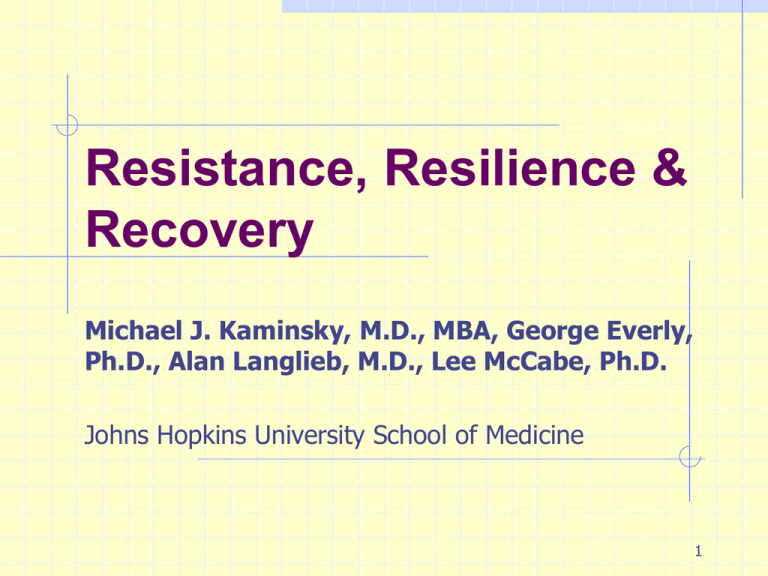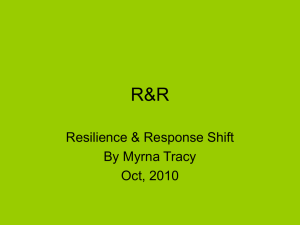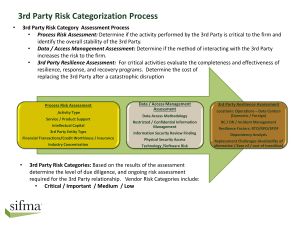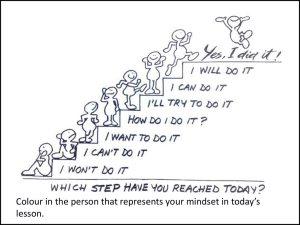Lessons Learned about Resiliency & Resistance
advertisement

Resistance, Resilience & Recovery Michael J. Kaminsky, M.D., MBA, George Everly, Ph.D., Alan Langlieb, M.D., Lee McCabe, Ph.D. Johns Hopkins University School of Medicine 1 Introduction 1. Crisis intervention should be multi- component in nature (British Psychological Society, 1990) 2. Early intervention includes a variety of interventions matched to the needs of the situation and the recipient populations along a continuum (NIMH, 2002; DHHS 2004) 2 Introduction Traditional models of disaster have emphasized temporal or phenomenological aspects 3 PHASES OF A DISASTER Warning Impact Heroic Disillusionment Reconstruction 4 anger anxiety heroism reconstruction impact shock depression despair Phases of Disaster (DHHS, 2004) 5 RESCUE 0-1 WK RECOVERY 1-4 WKS RETURN 2 WKS - 2 YRS Pre-incident IMPACT 0-48HRS Phases of Disaster (NIMH, 2002) 6 Critique and a Proposal Traditional models tend to be: Limiting—e.g. only some aspects of behavior or emotion Inflexible Event focused, not person, group or institution focused 7 Critique and a Proposal 1. Do not include assessment 1. 2. Of individuals Of organizations 2. Do not make predictions (hypotheses) that can be assessed post-event to establish effectiveness 3. Are reactionary, not proactive 4. Tend to propose one size fits all interventions, ignoring vulnerabilities An outcomes driven proposal: resistance/resilience/recovery (RRR) 8 RESISTENCE, RESILENCE, RECOVERY An outcome-driven continuum of care Build Resistance Assessment Intervention Evaluation Enhance Resiliency Assessment Intervention Evaluation Speed Recovery Assessment Intervention Evaluation [Kaminsky, et al, (2005) RESISTENCE, REILENCE, RECOVERY, Johns Hopkins. 9 ADVANTAGES OF OUTCOMEDRIVEN SYSTEM DESCRIPTIVE - PHASES COLLECTIVELY DEFINE THE PHENOMENOLOGICAL PROGRESSION IN THE CONTINUUM OF CARE TIME EPOCHS ARE RELATIVE, FLEXIBLE PRESCRIPTIVE - EACH PHASE PRESCRIPTIVELY DEFINES ITS OWN RESPECTIVE OBJECTIVES, DESIRED OUTCOME PRESCRIPTIVE NATURE LENDS ITSELF TO BEHAVIORAL EVALUATION 10 I. RESISTANCE In the present context, the term resistance refers to the ability of an individual, a group, an organization, or even an entire population, to literally resist manifestations of clinical distress, impairment, or dysfunction associated with critical incidents, terrorism, and even mass disasters. Resistance may be thought of as a form of psychological/ behavioral immunity to distress and dysfunction. 11 II. RESILIENCE In the present context, the term resilience refers to the ability of an individual, a group, an organization, or even an entire population, to rapidly and effectively rebound from psychological and/or behavioral perturbations associated with critical incidents, terrorism, and even mass disasters. 12 III. RECOVERY The term recovery refers to the ability of an individual, a group, an organization, or even an entire population, to literally recover the ability to adaptively function, both psychologically and behaviorally, in the wake of a significant clinical distress, impairment, or dysfunction subsequent to critical incidents, terrorism, and even mass disasters. 13 Tasks in the RRR Model Organizations/ Populations Groups Assess Resistance Intervene Evaluate Assess Intervene Evaluate Persons Assess Intervene Evaluate Resilience Assess Intervene Evaluate Assess Intervene Evaluate Assess Intervene Evaluate Recovery Assess Intervene Evaluate Assess Intervene Evaluate Assess Intervene Evaluate 14 The Johns Hopkins Perspectives on Disaster Psychiatry “RRR” Concepts DISEASE DIMENSIONS BEHAVIOR LIFE STORY What a person “has” “Who a person is” “What a person does” “What a person encounters” Hypotheses Hypotheses Hypotheses Hypotheses RESISTANCE A person may have somatically-based pathological conditions that compromise his/her immunity to stressors A person may have certain intellectual or personality traits that affect (+ or -) his/her immunity to stressors A person may have drives, habits, learned behaviors, etc that affect (+ or -) his/her immunity to stressors A person may have life encounters and resulting assumptive systems that can affect (+ or -) his/her immunity to stressors* RESILIENCE A person’s capacity to rebound from stressors, traumatic incidents, etc may be impaired by acute and chronic illness and disease (eg, via immunosuppression) A person’s intelligence, problemsolving ability, extraversion, optimism, etc can position him/her to “spring back” from a stressor faster than a person without such traits A person’s learned responses to external stressors, ie, one’s repertoire of active coping skills, in part, determine one’s resilience to such stressors A person’s psychosocial history (eg, in the contexts of family, school, and job settings) and the resulting assumptions about the value of interpersonal relationships as a personal resource are critical elements of resilience RECOVERY A person’s recovery from a disaster may be facilitated or impeded by the absence (or existence) of a physical or mental illness/disease process A person’s recovery from a disaster may be facilitated (or impeded) by certain intellectual and personality traits A person’s recovery from a disaster may be facilitated (or impeded) by previously learned behavioral tendencies, coping skills, etc. A person’s recovery from a disaster may be facilitated (or impeded) by prior life encounters, by the availability (or absence) of close interpersonal relationships, and be his/her sense of self efficacy Key focus for recovery An identifiable abnormality of structure or function Vulnerability due to intellectual sub-normality, unstable introversion, and affective/temperamental traits, etc. Maladaptive goal-directed and /or learned behavior; return to functioning Psychological distress, anxiety, demoralization, negative beliefs about self efficacy Key intervention for recovery Cure by way of appropriate medical treatment Guidance and support Increase, decrease, or extinguish problem behavior Recapitulation , rescripting, reframing, reconstrual, etc. 15 The Johns Hopkins Perspectives on Disaster Psychiatry DISEASE DIMENSIONS BEHAVIOR LIFE STORY What a person has Who a person is What a person does What a person encounters 16 The Johns Hopkins Perspectives on Disaster Psychiatry—Resistance Hypotheses Disease A person may have somatically-based pathological conditions that compromise his/her immunity to stressors. Dimensions A person may have certain intellectual or personality traits that affect (positively or negatively) his/her immunity to stressors. Behavior A person may have drives, habits, learned behaviors, etc that affect (positively or negatively) his/her immunity to stressors. Life Story A person may have life encounters, and resulting assumptive systems, that can affect (positively or negatively) his/her immunity to stressors. 17 Resistance—Assessment 1. Assess vulnerabilities, knowledge, beliefs and preparation of individuals 2. Assess quality of group cohesion/social support/organizational management 3. Assess availability of credible leadership 18 New Orleans Poverty, poor individual resources for transportation Large addiction population High community disability load: 65,000 disabled in population of 550,000 19 Resistance—Intervention Setting appropriate expectations, developing stress management and coping skills, and providing realistic pre-incident training may foster stress resistance (Lating, et al, 2003; Meichenbaum, 1985; Schiraldi & Brown, 2001, 2002; Seligman, Reivich, Jaycox, & Gillham, 1995; Chang, et al., 2004). 20 21 STATE OF MARYLAND DHMH: DISASTER MENTAL HEALTH VOLUNTEER CORPS TRAINING Disaster Mental Health Training for the Spiritual Caregiver Supported by a Special Projects grant from the Maryland Department of Health and Mental Hygiene, and administered through the Maryland Hospital Association with funding from the Health Resources and Services Administration (HRSA). Community Capacity Building Faith appropriate 4 ½ day sessions Disaster Mental Health 101 Psychological 1st aide Grief counseling Disaster planning 24 Build Resistance—Intervention The creation of group cohesion with an underlying infrastructure for social support may be useful (American Psychological Association, 2004). 25 Psychological Efforts to Build Resistance (APA, 2003) Pre-incident, Pre-deployment Group cohesion Social support Foster a sense of purpose 26 Build Resistance—Evaluation Piper Alpha oil platform disaster— psychoprophylactic role of good organization and sensitive staff management (Alexander, BJP, 1993) Preparation, interpersonal relationships, debriefing (Thompson and Solomon, Anxiety Research, 1991) 27 The Johns Hopkins Perspectives on Disaster Psychiatry—Resilience Hypotheses Disease A person’s capacity to rebound from stressors, traumatic incidents, etc may be impaired by acute and chronic illness and disease (eg, via immuno-suppression). Dimensions A person’s intelligence, problem-solving ability, extraversion, optimism, etc can position him/her to “spring back” from a stressor faster than a person without such traits. Behavior A person’s learned responses to external stressors, ie, one’s repertoire of active coping skills, in part, determine one’s resilience to such stressors. Life Story A person’s psychosocial history (eg, in the contexts of family, school, and job settings) and the resulting assumptions about the value of interpersonal relationships as a personal resource are critical elements of resilience. 28 “It is more important to know what sort of patient has a disease than what sort of disease a patient has”. William Osler 29 30 Traits Neuroticism— Assesses adjustment vs. emotional instability. Identifies individuals prone to psychological distress, unrealistic ideas, excessive cravings or urges, and maladaptive coping responses e.g. worrying, nervous versus calm, relaxed, unemotional 31 32 “Neuroticism” and Anxiety Disorders Predisposing factor Angst and Vollrath, 1991 – cohort of young adult males in Zurich – high “neuroticism” at 19 predicted onset of anxiety neurosis by age 36 Krueger, 1999 – Dunedin sample - high “negative emotionality” in late adolescence predicted onset of anxiety disorders by early adulthood 33 “Neuroticism” and Anxiety Disorders Predisposing factor Bramsen et al., 2000 – U.N. peacekeepers in the former Yugoslavia – high predeployment “psychoneuroticism” was second only to traumatic event exposure in predicting PTSD symptoms Fauerbach et al., 2000 – severe burn survivors – higher baseline neuroticism predicted onset of PTSD in the following year 34 The dimensional paradigm potential provocation response The neurotic paradigm or emotive triad temperamental shyness Low IQ speech requirement anxiety symptoms difficult cognitive task demoralization, with anxiety & depressive symptoms 35 A more complex example – interacting perspectives emotive paradigm personality vulnerabilities (e.g., neuroticism &/or introversion) disaster exposure anxiety, arousal, numbing, re-experiencing + behavioral perspective restriction of activities, impaired role functioning decreased discomfort avoidance of trauma-related places & memories Psychological Efforts to Build Resilience (APA, 2003)—Intervention During Provide strong leadership Work in teams, when possible Sustain an information flow Stay task oriented Utilize on-scene support services Remain vigilant for fatigue, distress, mistakes Promote recovery between incidents 37 Enhance Resilience—Intervention Acute Post-incident, Post Deployment Provide information about event, Provide information about normal behavioral reactions Emphsize social support Teach personal stress management, foster “self- efficacy” (Bandura, 1997) Address “relationship” issues Return to normal routines: diet, exercise “Debriefings” or similar organization-based crisis interventions should be considered. Cathartic ventilation should be voluntary! Utilize a phase sensitive disaster mental health system (Raphael, 1986; Everly & Mitchell, 1999)... 38 Enhance Resilience—Intervention Fostering group cohesion and interpersonal support Interpersonal support has been shown to buffer stress (Flannery, 1990). Group discussions, debriefings may be useful in enhancing cohesion, reducing distress, reducing maladaptive coping (NIMH, 2002, Tables 2-3) 39 Enhance Resilience—Intervention An essential element of fostering cohesion and support can be effective group communications. Communications should be designed to provide five essential elements: 1. 2. 3. 4. 5. information (and rumor deterrence), reassurance, direction, motivation, and a sense of connectedness. 40 Enhance Resilience—Intervention Self-Efficacy “People guide their lives by their beliefs of personal efficacy” (Bandura, 1997, p. 3). 41 Enhance Resilience—Intervention Foster Self-Efficacy “People’ s beliefs in their efficacy… influence the courses of action people choose to pursue, how much effort they put forth in given endeavors, how long they will persevere in the face of obstacles and failures, their resilience to adversity, whether their thought patterns are selfhindering or self-aiding, how much stress and depression they experience in coping with taxing environmental demands, and the level of accomplishments they realize” (Bandura, 1997, p.3). 42 Psychological First Aid Stabilize Assess and triage Communicate Connect SACC Model of Acute Psychological First Aid (Everly & Flynn, 2004) 43 Ørner’s TRACK system of responder resilience T—Talk about it but not beyond what you are ready to talk about R—Relax; do the things that normally relax you A—Activity; exercise, hobby, the active things that divert you. C—Control; re-establish everyday routine K—Kontemplate (Contemplate); don’t decide /conclude what it all means, wait and see. 44 Enhance Resilience—Evaluation Fostering positive cognitions. Cognitive appraisals appear to be key determinants of stress (see Everly& Lating, 2002, for a review) and trauma (Ehlers & Clark, 2003). Conversely, positive cognitions appears to deter excessive stress and foster resiliency (Affleck & Tennen, 1996; Meichenbaum, 1985; Taylor, 1983; Tedeschi & Calhoun, 1996). 45 Enhance Resilience—Evaluation LESSONS LEARNED FROM COMMUNITY MENTAL HEALTH Early Psychological Intervention may reduce the need for more intensive psych services. (Langsley, Machotka, & Flomenhaft, 1971, Am J Psyc; Decker, & Stubblebine, 1972, Am J Psyc) Early Psychological Intervention may mitigate acute distress . (Bordow & Porritt, 1979, Soc Sci & Med; Bunn & Clarke, 1979, Br. J Med. Psychol;Campfield & Hills, 2001, JTS; Everly, et al., 1999, Stress Med; Flannery & Everly, 2004, Aggression & Violent Beh.) Early psychological Intervention may reduce ETOH use. (Deahl, et al, 2000, Br J Med Psychol) 46 Enhance Resilience—Evaluation The Military Experience Treat near the front (SALMON, NYMedJ, 1919). “…Keep alive the [causal] relation between the symptoms and the traumatic event” [as opposed to attributing symptoms to weakness in character]” (KARDINER, Am. Hdbk. Psyc, 1959). Importance of principles of immediacy, proximity, and expectancy—70%-80% return to duty (ARTISS, Military Medicine, 1963) 47 Enhance Resistance—Evaluation SHALEV (1994, Debriefing Following Traumatic Exposure) Advocates the S.L.A. Marshall method of debriefing wherein groups of soldiers were encouraged to discuss events of combat shortly after the incidents themselves. He quotes Marshall, “Soldiers are eager to talk, their memory is good, they do so much better when together, in groups.” SHALEV, PERI, ROGEL-FUCHS (1998, Military Med) Applied Marshall’s historical group debriefing 7 hours after combat exposure (n=39). Results indicated the debriefing was followed by a reduction in anxiety, improvement in self-efficacy, increased group cohesion. 48 The Johns Hopkins Perspectives on Disaster Psychiatry—Recovery Hypotheses Disease A person’s recovery from a disaster may be facilitated or impeded by the absence (or existence) of a physical or mental illness/disease process. Dimensions A person’s recovery from a disaster may be facilitated (or impeded) by certain intellectual and personality traits. Behavior A person’s recovery from a disaster may be facilitated (or impeded) by previously learned behavioral tendencies, coping skills, etc. Life Story A person’s recovery from a disaster may be facilitated (or impeded) by prior life encounters, by the availability (or absence) of close interpersonal relationships, and be his/her sense of self efficacy. 49 Recovery From PTSD After Rape 94% 47% 42 % % with PTSD Symptoms 30 % 25%-15% ? W 3m 9m12m Data from Rothbaum et al., 1992 Years 50 Prevalence of Trauma and PTSD in Men and Women in the US 100 91.9 90 79.6 Percent (%) 80 70 60 60.7 Trauma PTSD No PTSD 51.2 50 40 30 20.4 20 10 8.1 0 Men Women Kessler 1995 51 Rate of PTSD is Influenced by the Nature of the Trauma 60 Trauma PTSD Percent (%) 50 40 30 20 10 0 Disaster Kessler, 1995 Accident Assault Molestation Combat* Rape 52 Evidence of Traumatic Damage to the brain 1. Left Hippocampal over- activity after trauma 2. Left Hippocampal atrophy after trauma 3. Cell loss thought secondary to excitatory toxicity/apoptosis. 4. Psychological event/exposure possibly directly damaging the brain 53 PE Vs SIT Vs PE/SIT Vs WL Percent Patients with PTSD 100 PE SIT PE/SIT WL 90 80 70 60 50 40 30 20 10 0 Post-Tx Foa et al., 1999 6 Mo FU Last Available FU (M = 10.7 mos.) 54 Effect Size of PTSD Symptoms Post-Rx Effect Sizes* of PE vs SIT vs PE/SIT: PTSD PE SIT SIT/PE 2 1.5 1 0.5 0 TOTAL Reexp. Arousal *Effect size compared to wait-list group at posttreatment Avoidance Foa et al., 1999 PTSD Severity PE VS PE and CR With Torture Victims 45 40 35 30 25 20 15 10 5 0 PE PE/CR Pre Post FU Paunovic & Ost, 2001 56 Study with Men and Women Victims of Mixed Traumas Treatments: Exposure (PE) Cognitive Restructuring (CR) PE + CR Relaxation Training Treatment consisted of 10 sessions conducted over 16 weeks Marks et al., 1998 57 Good End State Functioning Post Treatment* Perecent Responders 60 50 40 30 20 10 0 PE SIT PE/SIT Foa et al., 1999 WL PE CR R Marks et al., 1998 * > 50% improved on PTSD; <7 BDI; <35 STAI-S PE/CR 58 “Worried well” 1. Who came up with this designation? Certainly not a mental health person. 2. In standard medical culture- a PERJORATIVE (means hypochondria, crock, someone without a serious problem). 3. Effect is to discount the very psychological effects that are the purpose of terror 59 “Worried well” (cont’d) 1. Stop using the term 2. Substitute Uninjured affected Psychologically effected 60 A Lesson: Never give in. Never give in. Never, never, never, never -- in nothing, great or small, large or petty, never give in, except to convictions of honour and good sense. Never yield to force. Never yield to the apparently overwhelming might of the enemy. Winston Churchill, October 29, 1941 Harrow School, England 61








